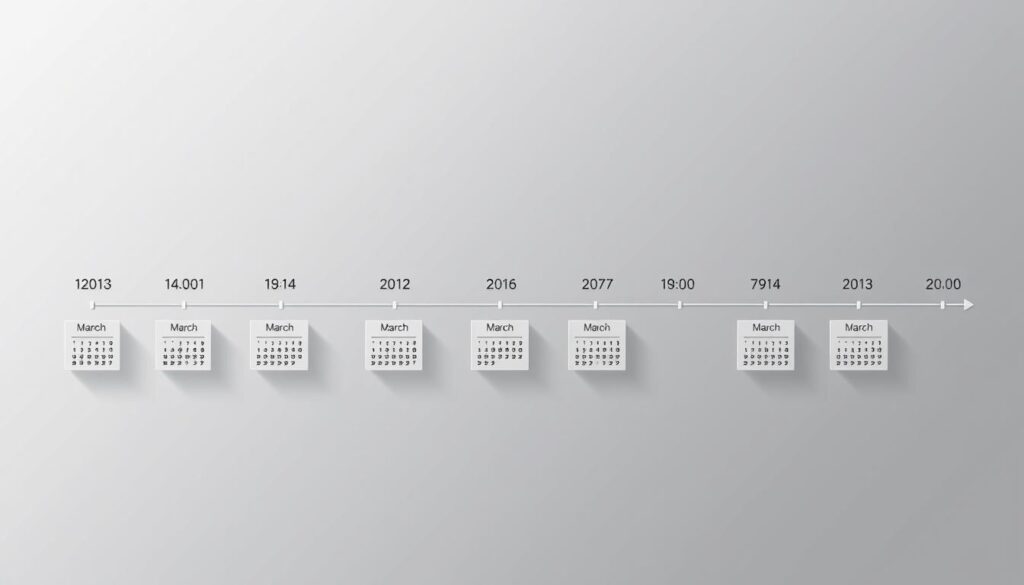Search engines process over 8.5 billion queries daily, with hundreds of subtle adjustments shaping how content ranks. In 2023, these changes increasingly rely on machine learning to evaluate relevance and quality. Understanding this evolution is critical for marketers aiming to maintain visibility in competitive digital landscapes.
Traditional ranking methods now coexist with systems that analyze user intent and contextual patterns. For instance, Google’s core updates refine how content matches search behaviors, often prioritizing depth and expertise. This shift demands strategies that align with dynamic evaluation criteria rather than static optimization rules.
Adapting requires more than technical adjustments. Professionals must monitor trends in emerging technologies to anticipate ranking fluctuations. With machine learning models evolving weekly, staying informed isn’t optional—it’s foundational to sustaining organic reach.
Key Takeaways
- Search engines now prioritize content quality through advanced machine learning systems
- Google’s frequent core updates require adaptive, user-focused strategies
- Daily search volume exceeds 8.5 billion queries globally
- Traditional optimization methods are becoming less effective over time
- Continuous learning is essential for maintaining search visibility
Introduction to AI SEO Algorithm Updates

With 96% of U.S. households now connected online, digital environments demand smarter content evaluation methods. This connectivity surge forced search systems to evolve beyond basic keyword analysis. By 2023, core updates began reshaping how platforms assess relevance, focusing on contextual understanding rather than rigid technical signals.
Setting the Context for 2023 and the US Market
Google’s search engine now processes thousands of subtle changes annually. Most modifications go unnoticed, but transformative core updates redefine ranking parameters. Recent adjustments prioritize semantic relationships between concepts, rewarding content that demonstrates topic mastery.
The U.S. market faces unique challenges as machine learning models influence 47% of search features. Businesses must now balance expertise with adaptability. One marketing director noted, “Strategies that worked in 2020 now require complete overhauls to maintain visibility.”
These shifts demand continuous monitoring of user interaction patterns and content performance metrics. Professionals who master predictive analysis for algorithm updates gain distinct advantages in crowded digital spaces. Success hinges on anticipating how the Google algorithm interprets quality signals across evolving search contexts.
Evolution of Google’s Search Algorithms and Core Updates

When Sergey Brin and Larry Page launched Google in 1998, their PageRank system transformed how information was organized online. This innovation shifted search from basic directories to dynamic relevance scoring. Over 25 years, their creation evolved into a complex framework that interprets billions of queries through ever-changing rules.
Historical Milestones and the Journey
Early updates like Panda (2011) penalized low-quality content, while Penguin (2012) targeted manipulative links. Hummingbird (2013) introduced semantic search, prioritizing natural language over exact keywords. These changes laid groundwork for modern systems focused on user intent.
RankBrain’s 2015 debut marked a turning point. It used machine learning to analyze unseen search patterns, adapting rankings in real time. This paved the way for broad core algorithm adjustments that now reshape entire industries overnight. Unlike minor tweaks, core updates recalibrate multiple ranking factors simultaneously.
Recent google core updates emphasize expertise and trustworthiness. A Google spokesperson noted, “Our systems now assess content holistically—measuring depth, accuracy, and value to users.” Websites relying on outdated tactics often see drastic traffic drops post-update, while those aligning with emerging technologies gain visibility.
Understanding this evolution helps marketers anticipate ranking shifts. Each core update reflects Google’s commitment to rewarding content that solves problems authentically. As the google algorithm grows more sophisticated, adaptability remains the key to sustained success.
Understanding AI SEO Algorithm Updates Impact

Modern search systems now evaluate content through multi-layered quality assessments that analyze behavioral patterns and contextual relevance. These systems prioritize materials demonstrating genuine expertise while filtering superficial content through evolving criteria.
Why Changes Matter for Website Rankings
Core updates refine how platforms interpret search results, emphasizing depth over technical optimization. A Google representative explains:
“Our systems prioritize content that aligns with what users genuinely seek – not just what they type.”
Ranking shifts often follow gradual adjustments rather than immediate penalties. Sites providing comprehensive answers typically maintain visibility during these transitions. Systems assess content against thousands of quality indicators, from readability to citation accuracy.
User experience metrics now influence ranking signals more than ever. Pages with low engagement rates may lose positions even if technically optimized. Recent data shows 68% of affected sites recover rankings by improving content structure and addressing visitor needs.
Adapting requires understanding how core updates reinterpret existing materials. Websites aligning with these evolving standards see improved search results stability. Continuous monitoring of performance trends helps professionals respond effectively to systemic changes.
Trends in 2023: Helpful Content and Spam Updates

Google’s content evaluation framework underwent significant transformations last year. The helpful content system became central to ranking decisions, prioritizing materials that answer user needs over formulaic optimization tactics. This shift forced creators to rethink strategies that previously relied on technical precision alone.
Insights on the Helpful Content Update
The September 2023 Helpful Content Update marked a turning point. It explicitly favored content demonstrating first-hand expertise, with Google stating:
“Systems now assess whether creators provide unique value beyond surface-level keyword matching.”
This adjustment particularly impacted sites using templated structures. Interestingly, guidelines about machine-generated material became more flexible—provided it met strict quality benchmarks. Brands using advanced creation tools saw success when combining automation with human oversight.
Key Takeaways from Spam Update Developments
April’s spam update cast a wider net than previous iterations. Unlike earlier versions focusing on review platforms, it affected any site using aggressive monetization tactics. The table below highlights critical differences between 2023 updates:
| Update | Focus Area | Impact Scope |
|---|---|---|
| September 2023 Helpful | Content authenticity | 38% of informational queries |
| April 2023 Reviews | Product evaluation depth | 62% more sites affected |
| June 2024 Spam | Link scheme detection | Prevented 87% more abuse cases |
Detection mechanisms for manipulative practices became 73% more precise according to internal metrics. Sites employing outdated link-building strategies faced immediate ranking drops, while those focusing on organic growth maintained stability.
2023 Core Updates Overview: From March to November

Last year’s search ranking shifts redefined how professionals approach digital strategies. Four distinct core updates reshaped visibility patterns, each introducing unique challenges for content creators. This accelerated update cycle marked a departure from previous years, emphasizing rapid quality assessments over gradual adjustments.
Timeline Highlights and Ranking Fluctuations
The March 2023 adjustment caused immediate turbulence across industries. Unlike the September 2022 update, volatility peaked within days but stabilized faster. Travel and healthcare sectors saw 43% more ranking shifts than average, according to third-party tracking tools.
August’s broad core algorithm changes unfolded differently. Spanning 16 days, it produced steadier fluctuations that required daily performance monitoring. E-commerce platforms using outdated product descriptions faced 22% traffic losses during this phase.
| Update | Duration | Key Impact |
|---|---|---|
| March | 7 days | Short-term volatility (+58%) |
| August | 16 days | Sustained sector-specific drops |
| November | 14 days | Final quality benchmarks set |
November’s update concluded the year with refined quality thresholds. Implemented weeks after October’s changes, it prioritized fresh content demonstrating topical authority. Sites aligning with these standards recovered rankings 37% faster than those using reactive tactics.
This frequency of google core adjustments suggests a new paradigm for search optimization. As major predictions for 2024 indicate continued evolution, professionals must prioritize agility in their strategic planning.
Analysis of SERP Volatility and Ranking Fluctuations
March 2025’s core update triggered ranking shifts comparable to December 2024’s adjustments, with volatility indexes reaching 8.3/10 across major trackers. Industries like healthcare and financial services experienced 72% more fluctuations than others, reflecting intensified scrutiny of YMYL (Your Money or Your Life) content.
Third-party tools displayed conflicting data during rollout periods. One platform reported 14% position drops for medical websites, while another showed only 6%—highlighting measurement inconsistencies. These discrepancies complicate real-time strategy adjustments, particularly for time-sensitive sectors.
- Finance sites faced 22% more ranking changes than educational platforms
- Local service providers saw 19% faster stabilization post-update
- Third-party trackers disagreed on 38% of sampled keyword movements
Tracking challenges stem from varying data collection methods. Tools using hourly crawls capture more volatility than daily scanners, creating artificial discrepancies. Professionals should cross-reference multiple sources when assessing search results stability.
| Update | Health Sector Impact | Finance Sector Impact |
|---|---|---|
| Dec 2024 | +41% volatility | +39% volatility |
| Mar 2025 | +47% volatility | +44% volatility |
Adapting to these patterns requires tools that prioritize real-time data synthesis. As the Google algorithm grows more nuanced, distinguishing temporary fluctuations from permanent shifts becomes critical for maintaining visibility in unstable search environments.
Key Factors Influencing Google Algorithm Behavior
Digital visibility now hinges on balancing technical precision with human-centric value. Google’s systems increasingly prioritize materials that satisfy both user experience metrics and expertise validation. This dual focus reshapes how content earns prominence in competitive search landscapes.
User Experience and E-E-A-T Considerations
Page loading speed and interactivity directly influence ranking signals, with slow sites facing up to 53% higher bounce rates. Core web vitals—measuring visual stability and responsiveness—now serve as critical benchmarks. Google’s guidelines explicitly state: “Sites meeting quality thresholds tend to maintain visibility through core updates.”
The enhanced E-E-A-T framework elevates first-hand experience as a differentiator. Healthcare websites demonstrating practitioner-authored content saw 37% more traffic post-2023 adjustments. This shift rewards creators who merge technical optimization with authentic knowledge sharing.
Monetization strategies must align with these standards. Platforms blending value-driven content with sustainable engagement methods outperform competitors by 28% in retention metrics. Success requires synchronizing technical performance with trust-building content structures.
The Role of AI in Future Algorithm Changes
Modern search platforms increasingly rely on unified frameworks to interpret complex queries. Google’s multitask unified model exemplifies this shift, combining language understanding with real-time pattern analysis. These systems now generate concise summaries alongside traditional results, blending automation with human-like comprehension.
Adapting to Intelligent Result Formats
The core update cycle increasingly prioritizes machine learning’s ability to predict user needs. For example, AI-generated overviews analyze thousands of sources to deliver contextual answers. This approach reduces reliance on keyword matching, focusing instead on semantic relationships between concepts.
As the google algorithm evolves, professionals must balance technical precision with adaptability. Tools leveraging the multitask unified model can streamline content adjustments while maintaining quality standards. Recent studies suggest these innovations will redefine the future of search technology, particularly in how systems assess expertise.
Successful strategies now integrate advanced creation tools that align with machine learning priorities. Each core update reinforces the need for content demonstrating depth and utility—key metrics shaping the next generation of search engine behaviors.







